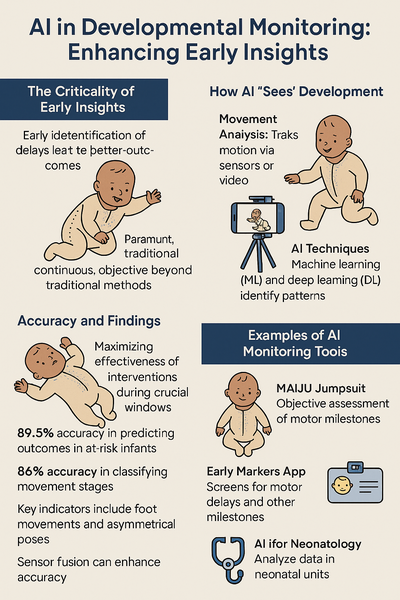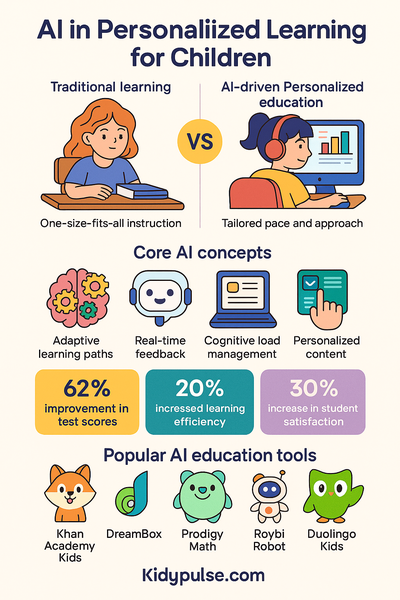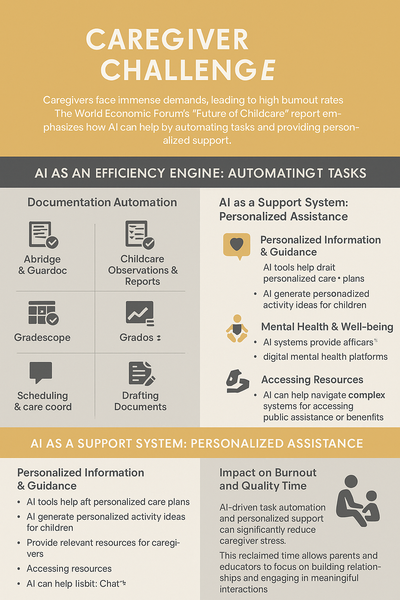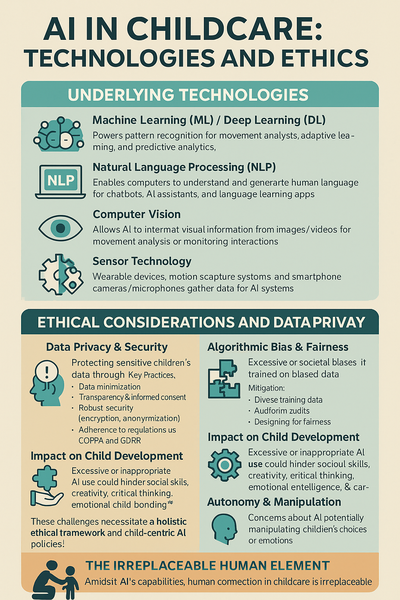AI-Powered Childcare: Ushering in a New Era of Support, Safety & Smart Parenting

Discover how AI is transforming childcare—enhancing safety, education & personalized parenting. A smarter future starts here.
Introduction: The Dawn of AI in Childcare
Technology's integration into daily life continues to accelerate, reshaping industries from finance to healthcare. Early childhood education and care (ECEC) is no exception, witnessing a shift from basic digital tools towards more sophisticated applications driven by artificial intelligence (AI). This evolution sparks both excitement and critical reflection, as AI promises unprecedented opportunities while demanding careful consideration of its impact on our youngest learners and their caregivers.
The potential of AI in the childcare landscape appears multifaceted, offering a triple promise centered around three core pillars:
- Supporting Child Development: AI tools show potential for enhancing early developmental monitoring. For instance, research from Stanford University indicates that AI-powered tools can predict developmental milestones in infants with up to 90% accuracy, enabling the detection of subtle patterns or potential risks much earlier than traditional methods might allow, thereby facilitating timely intervention.
- Enhancing Learning: AI-driven educational platforms can offer personalized learning experiences. A study published in the journal "Nature" reveals that such apps can effectively adapt to a child's learning pace, improving cognitive development by an average of 15%.
- Aiding Caregivers: AI applications aim to alleviate the significant administrative burden faced by childcare professionals and parents. The "Future of Childcare" report by the World Economic Forum highlights the potential of AI to reduce caregiver burnout by automating tasks and providing personalized support.
While the allure of these advancements is strong, it is crucial to approach this new era with a balanced perspective. The integration of AI into the sensitive realm of childcare necessitates responsible innovation, rigorous ethical scrutiny, and an unwavering commitment to preserving the essential human element in care and education. This blog post aims to provide an evidence-based overview by delving into the broader evidence and specific, verifiable findings to paint a nuanced picture of AI's emerging role. We will explore the capabilities, documented benefits, underlying technologies, and critical ethical considerations shaping the future of parenting and childcare.
Section 1: AI as a Partner in Monitoring Early Development

The Criticality of Early Insights
The first few years of life are a period of rapid and foundational development. Monitoring this development is paramount, as early identification of potential delays allows for timely interventions, significantly improving long-term outcomes. Traditionally, this relies on parental reports, caregiver observations, and periodic screenings. While valuable, these methods can be subjective and infrequent. AI presents a potential paradigm shift, offering tools for more continuous, objective, and data-driven developmental surveillance. For a deeper dive into typical developmental stages, check out our child developmental milestones guide.
How AI "Sees" Development
AI systems leverage sophisticated techniques to gather and interpret developmental data, often focusing on observable behaviors like movement.
- Movement Analysis: AI algorithms can process movement data captured via specialized equipment, wearable sensors (like smart jumpsuits), or even standard smartphone cameras. These systems track motion, analyzing patterns, frequency, quality, and symmetry.
- AI Techniques: Machine learning (ML) and deep learning (DL) models are core to this analysis. Simpler ML classifiers and more complex DL models (like Convolutional Neural Networks) analyze nuanced movement patterns, classify actions, identify developmental stages, and detect subtle anomalies.
This technological approach moves beyond simple observation towards quantifiable analysis, offering a more granular view of an infant's developmental trajectory.
Accuracy and Findings
Research exploring AI's capabilities in developmental monitoring has yielded promising results:
- Predicting Outcomes: AI models using motion recordings and demographic data achieved an 89.5% overall accuracy in predicting future developmental outcomes in at-risk infants. This aligns with the widely cited Stanford research suggesting up to 90% accuracy in predicting developmental milestones.
- Classifying Movement Stages: A deep learning model demonstrated 86% accuracy in classifying infants' engagement stages by analyzing only foot movements.
- General Movement Assessment (GMA): AI augmenting GMA, even with single sensor modalities like video, reports classification performances around the 90% accuracy level, competing with trained human assessors.
- Sensor Fusion Advantage: Combining data from multiple sensors (sensor fusion) significantly enhances accuracy, with one study achieving 94.5% accuracy in classifying infant motor patterns.
- Key Movement Indicators: AI has identified specific movements, like foot movements or asymmetrical poses in a crib, as highly indicative of developmental interactions or potential risks for conditions like ASD.
Implications for Early Intervention
AI's ability to provide objective, continuous, and accurate developmental insights has profound implications. Traditional screening might occur at 9, 18, and 30 months. AI-powered monitoring could facilitate much earlier identification of developmental differences, allowing for interventions during crucial developmental windows, maximizing their effectiveness.
Examples of AI Monitoring Tools
- MAIJU Jumpsuit: A smart jumpsuit using AI for objective assessment of infant motor milestones at home.
- Early Markers App: Uses smartphone video and AI to screen infants for motor delays and other milestones.
- AI for Neonatology: Applied in NICUs to analyze data streams for survival analysis, neurological development assessment, and diagnosing conditions in vulnerable newborns.
- Motion-Based Classification Systems: Wearable sensors collect movement data for AI classifiers to distinguish between typically developing infants and those at risk.
These examples illustrate the shift towards more accessible and continuous developmental surveillance, potentially democratizing early screening.
Section 2: Enhancing Cognitive Growth with AI-Driven Education

The Promise of Personalization
Beyond physical development, AI is poised to reshape learning. Traditional education often follows a "one-size-fits-all" approach. Personalized learning, tailoring experiences to the individual, is where AI can be a powerful catalyst, offering individualized instruction at scale.
Mechanisms of AI Adaptation
AI-driven educational tools employ various mechanisms for personalization:
- Adaptive Learning Paths: Algorithms analyze student performance (accuracy, time taken, interaction patterns) to dynamically adjust content difficulty and sequence.
- Cognitive Load Management: AI systems can infer a learner's cognitive state and adjust information complexity to optimize learning efficacy.
- Real-Time Feedback: AI tools provide immediate, specific feedback, helping students understand mistakes and reinforce correct concepts promptly.
- Content Personalization and Interaction: AI can tailor content type (videos, articles) and use Natural Language Processing (NLP) for AI-powered tutors and chatbots to engage in dialogue.
Evidence of Cognitive Benefits
Studies show tangible benefits of AI in education:
- Improved Test Scores: Students using Knewton's AI-powered program showed a 62% improvement in test scores.
- Enhanced Math Performance: An intelligent tutoring system improved students' math learning performance by over 20%; another AI system boosted fifth graders' math grades by 30% and reduced learning anxiety by 20%.
- Increased Learning Efficiency: An AI-based learning model increased students' learning efficiency by 20% on average. The study highlighted in "Nature" which found AI-driven apps can improve cognitive development by an average of 15% further supports this.
- Higher Accuracy and Satisfaction: An AI-assisted tutoring system reportedly increased answer correctness from 80% to 95%, with a 30% increase in student satisfaction.
- Critical Thinking and Problem-Solving Support: AI can assist in academic research and scrutinizing theories, and foster problem-solving skills, though over-reliance is a concern. Explore fun brain-boosting activities to complement AI learning.
Examples of AI Educational Tools
- Comprehensive Platforms: Khan Academy Kids, DreamBox Learning.
- Subject-Specific Apps: Prodigy Math, Duolingo Kids, Photomath.
- Interactive Tools: Osmo (blending physical and digital play), Roybi Robot.
- Coding/STEM: CodeSpark Academy.
- Assessment/Feedback Tools: Illumine's AI Assessment, AI-powered writing assistants.
- Tutoring Systems: Georgia Tech's Jill Watson chatbot (97% accuracy in handling student inquiries).
The capacity for personalization holds promise, but balancing AI's strengths with independent thought and addressing data privacy are crucial.
Section 3: Supporting the Supporters: AI for Caregivers

The Caregiver Challenge
Caregivers face immense demands, leading to high burnout rates due to administrative workloads, emotional stress, and long hours. The World Economic Forum's "Future of Childcare" report underscores this "care crisis," emphasizing how AI can help by automating tasks and providing personalized support, thereby reducing caregiver burnout.
AI as an Efficiency Engine: Automating Tasks
AI can automate or speed up time-consuming administrative tasks:
- Documentation Automation:
- Charting & Clinical Notes: Tools like Abridge and Guardoc auto-generate summaries.
- Childcare Observations & Reports: Platforms like iCare AI, K-Buddy, and Illumine assist educators with daily reports and milestone tracking.
- Lesson Planning: Tools like Brisk Teaching and K-Buddy help generate lesson plans.
- Grading: AI tools like Gradescope can reduce grading time by up to 70%.
- Administrative Automation:
- Scheduling & Care Coordination: Apps like Reclaim.ai and platforms like Wellthy help manage complex schedules.
- Communication: Chatbots handle FAQs; platforms like Brightwheel and Illumine generate personalized updates for parents.
- Financial Management: Apps like Mint and YNAB assist with budgeting; tools like Carefull monitor finances for fraud.
- Drafting Documents: Generative AI like ChatGPT assists with writing emails or care plans.
AI as a Support System: Personalized Assistance
Beyond automation, AI offers personalized support:
- Personalized Information & Guidance:
- Care Plans: AI tools help draft personalized care plans.
- Activity Ideas: AI generates personalized activity ideas for children.
- Targeted Educational Content: AI systems provide relevant resources for caregivers.
- Mental Health & Well-being:
- Mental health chatbots like Tess offer customized support for family caregivers.
- Digital mental health platforms offer CBT-based programs for stress management.
- Accessing Resources: AI can help navigate complex systems for accessing public assistance or benefits.
Impact on Burnout and Quality Time
AI-driven task automation and personalized support can significantly reduce caregiver stress. This reclaimed time allows parents and educators to focus on building relationships and engaging in meaningful interactions, which is vital for mindful parenting and staying present.
Examples of AI Caregiver Support Tools
- Documentation/Admin: Abridge, Guardoc, Brisk Teaching, iCare AI, K-Buddy, Illumine, Gradescope.
- Coordination/Scheduling: Wellthy, Reclaim.ai.
- Financial: Carefull, Mint, YNAB.
- Personalized Support/Info: ChatGPT, Tess chatbot, The Cape (parenting insights), story/activity generators, kidypulse nutriAI.
- Communication: Brightwheel.
AI acts as a "co-pilot," enhancing the human caregiver's capacity.
Section 4: Navigating the Future: Technology, Ethics, and the Human Touch

As AI integrates into childcare, understanding its technologies and navigating ethical challenges is critical.
Underlying Technologies
- Machine Learning (ML) / Deep Learning (DL): Power pattern recognition for movement analysis, adaptive learning, and predictive analytics.
- Natural Language Processing (NLP): Enables computers to understand and generate human language for chatbots, AI assistants, and language learning apps.
- Computer Vision: Allows AI to interpret visual information from images/videos for movement analysis or monitoring interactions.
- Sensor Technology: Wearable devices, motion capture systems, and smartphone cameras/microphones gather data for AI systems.
Ethical Considerations and Data Privacy
The deployment of these technologies requires careful ethical consideration:
- Data Privacy & Security: Protecting sensitive children's data is paramount.
- Key Practices: Data minimization, transparency & informed consent, robust security (encryption, anonymization). Adherence to regulations like COPPA and GDPR is essential. Learn more about our commitment on our privacy page.
- Algorithmic Bias & Fairness: AI can perpetuate societal biases if trained on biased data.
- Mitigation: Diverse training data, algorithm audits, designing for fairness.
- Impact on Child Development: Excessive or inappropriate AI use could hinder social skills, creativity, critical thinking, emotional intelligence, and caregiver-child bonding.
- Safeguards: Balance screen time, prioritize human interaction, demand developmentally appropriate design.
- Transparency & Accountability: "Black box" AI models make it hard to understand decisions.
- Needs: Striving for interpretable models and clear communication about AI capabilities.
- Autonomy & Manipulation: Concerns exist about AI potentially manipulating children's choices or emotions.
- Empowerment: Foster digital literacy and critical thinking.
- Professional Ethics: Educators must avoid misrepresenting AI-generated content as their own insights.
These challenges necessitate a holistic ethical framework and child-centric AI policies.
The Irreplaceable Human Element
Amidst AI's capabilities, human connection in childcare is irreplaceable. AI should augment, not replace, human capabilities. Empathy, intuition, relationship-building, ethical judgment, and responsive caregiving are uniquely human and fundamental. The way adult behavior shapes child development through these interactions cannot be replicated by technology.
Conclusion: Embracing AI Responsibly in Childcare
Artificial intelligence is opening a new chapter in childcare, offering transformative potential in developmental monitoring, personalized education, and caregiver support. From early warnings of developmental delays to tailored educational content and reduced caregiver burnout, AI tools can significantly enhance the ECEC landscape.
However, this potential must be pursued with profound responsibility. Prioritizing children's well-being means robust data privacy, mitigating algorithmic bias, critically evaluating developmental impacts, and demanding transparency. Technology must always serve human connection.
The future of AI in childcare depends on choices made today. By fostering research, critical evaluation, and collaboration among all stakeholders, we can guide AI's development ethically and equitably. If navigated thoughtfully, AI can become a powerful ally, contributing positively to the support, growth, and flourishing of future generations. Explore more insights on our blog.
FAQs About AI-Powered Childcare: Ushering in a New Era of Support, Safety & Smart Parenting
- Question:
What is AI-powered childcare? - Answer:
AI-powered childcare refers to the use of artificial intelligence technologies to support parents, caregivers, and childcare providers in ensuring children’s safety, development, and wellbeing. It includes tools like smart baby monitors, AI-based learning apps, personalized parenting recommendations, and real-time safety alerts, all designed to make parenting smarter and more responsive. - Question:
How can AI improve child safety at home? - Answer:
AI enhances child safety by using sensors, cameras, and machine learning to monitor environments in real time. Smart baby monitors, for instance, can detect unusual breathing patterns or movements, while AI home systems can alert parents if a child enters a restricted area or is in danger, offering peace of mind and quicker responses. - Question:
Can AI help parents with daily routines? - Answer:
Yes, AI can assist with scheduling, reminders, and customized routines based on a child’s age and needs. Apps powered by AI can suggest mealtimes, nap times, and learning activities, adapting based on behavior patterns to create healthier and more productive routines for both kids and parents. - Question:
Is AI-based parenting safe and reliable? - Answer:
AI tools for parenting are generally safe when sourced from trusted companies that prioritize data privacy and security. While AI can provide valuable insights and support, it should complement—not replace—human judgment. Parents should always be actively involved and use AI as a guide, not a substitute. - Question:
How does AI support children’s learning and development? - Answer:
AI-powered learning platforms analyze a child’s learning pace, strengths, and challenges to offer personalized educational experiences. These tools can suggest age-appropriate content, adjust difficulty levels in real-time, and even provide feedback to parents on developmental milestones.
Sources used in this blog
New AI Unlocks the Secrets of Infant Learning and Development
News | Immunology | Stanford Medicine
Challenging Cognitive Load Theory: The Role of Educational ...
Toward Predicting Infant Developmental Outcomes From Day-Long ...
(PDF) Enhancing Early Childhood Cognitive Development via Mobile Game-Based Learning Applications: Insights and Practical Experiences - ResearchGate
(PDF) Artificial Intelligence in Neuroeducation: A Systematic Review of AI Applications Aligned with Neuroscience Principles for Optimizing Learning Strategies - ResearchGate
How Stanford Medicine is capturing the AI moment
AI in the Classroom: Insights from Educators on Usage, Challenges, and Mental Health
AI in pediatrics: Past, present, and future
Artificial intelligence (AI) -integrated educational applications and college students' creativity and academic emotions
Full article: Critical thinking in the AI era: An exploration of EFL students' perceptions, benefits, and limitations - Taylor & Francis Online
The past, current, and future of neonatal intensive care units with artificial intelligence: a systematic review
New Era of Artificial Intelligence in Education: Towards a ... - MDPI
Rising Demand For Caregivers Highlights Long-term Care Economics - WEF - Bernama
Dennis Wall - Stanford Profiles
Role of Artificial Intelligence in Enhancing Learning Outcomes of Pre-Service Social Studies Teachers Abdulaziz Al-Shammari1 &am
Artificial intelligence in mathematics education: A systematic literature review
The future of the care economy relies on collaboration and a 'care mindset'
How Investors Can Shape AI for the Benefit of Workers
AI predicts developmental paths in premature babies - EurekAlert!
We're living in a caregiving crisis | UNLEASH
This AI helps parents and caregivers access paid leave - The World Economic Forum
Innovative infant wearable uses artificial intelligence for at-home assessments of early motor development | ScienceDaily

Comments
No comments yet. Be the first to leave a comment!